|
|
|
Sort Order |
|
|
|
Items / Page
|
|
|
|
|
|
|
| Srl | Item |
| 1 |
ID:
184215
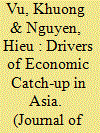

|
|
|
|
|
| Summary/Abstract |
This paper conducts a comprehensive examination of the sources of economic growth and catch-up of ASEAN countries since the Asian Financial Crisis, with comparative views of China and India. The study employs different decomposition frameworks to gain insights into the drivers of the Association's economic performance over the 1997–2017 period. Three findings are most notable. First, all ten member states, except for Brunei, recorded a strong catch-up performance, with labour productivity being the leading driver in most countries. Second, the drivers of labour productivity catch-up exhibit some distinctive patterns among countries, which depend on the level of income and economic structure. Third, in all decomposition analyses, ASEAN countries are well below China and India across sources of growth, which tends to suggest that countries in the grouping could improve their performance by enhancing market integration and policy coordination. Although the long-term prospect of ASEAN is bright, the COVID-19 pandemic and the recent military coup in Myanmar have indicated that the road to future prosperity of the region is expected to face formidable challenges.
|
|
|
|
|
|
|
|
|
|
|
|
|
|
|
|
| 2 |
ID:
113695
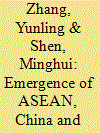

|
|
|
|
|
| Publication |
2012.
|
| Summary/Abstract |
The rise of ASEAN, China and India as economic powers is of great significance to regional as well as global economic development. Although their ascendance in the global economy will continue, they will have to go to great pains to meet the new challenges. Considering ASEAN, China and India as a group, due to their differences in economic development levels, economic structures and policy concern priorities, it is difficult for them to formulate a unified position on a range of global issues. ASEAN, China and India must foster an open, transparent and efficient regional as well as global environment. They need to cooperate in designing the architecture to ensure regional as well as global freer trade and investment and more stable finance, and to play more active roles in future global governance and rulemaking.
|
|
|
|
|
|
|
|
|
|
|
|
|
|
|
|
| 3 |
ID:
160496
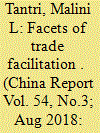

|
|
|
|
|
| Summary/Abstract |
The theoretical underpinnings of trade facilitation (TF) would suggest a ‘balanced growth’ approach to expedite trade. However, taking the example of China and India, in this article, we explore how selective measures are capable of addressing issues related to TF. Both the economies offer very innovative interventions to address issues corresponding to TF, especially embedded in the way institutions are coordinated and integrated. As against the conventional idea that TF has to be initiated and carried forward only by the government, the ‘One Touch’ initiative in China provides a role for public–private partnership on issues pertaining to TF. This clearly demonstrates how, besides generating demand for trade-logistics services, the private sector itself can act as a source of supply to such services. The operation of Grapenet in India highlights the need to focus on sector-specific TF requirements along with meeting multilateral obligations. The One Touch initiative has to be appreciated as it was brought about in a context of the limited evolution of the information technology (IT) platform in China, and Grapenet has to be appreciated specifically because it brought a paperless integrated system in an agricultural context in India, where this sector’s preparedness for TF is less than that of the manufacturing sector.
|
|
|
|
|
|
|
|
|
|
|
|
|
|
|
|
| 4 |
ID:
143991


|
|
|
|
|
| Summary/Abstract |
The long-awaited dream of Asians, that 21st century will belong to East, is now approaching towards fulfillment as the global geo-politics appears to be moving Eastward to Asia-Pacific and Indian Ocean regions away from traditional Atlantic Euro-American power centre of the world. In fact, today East Asia’s growth trajectory is represented not only by China and India, but also by the rise of the entire region. Consequently, its overall weight in global affairs is also increasing significantly, and hence developments here will have major implications for the rest of the world.
|
|
|
|
|
|
|
|
|
|
|
|
|
|
|
|
| 5 |
ID:
186354
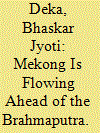

|
|
|
|
|
| Summary/Abstract |
This article analyses the hydro-political behaviour of riparian countries in the Mekong River Basin (MRB) vis-à-vis India’s attitude towards the Brahmaputra and upstream China. It analyses transboundary water cooperation in the MRB and the active participation of the stakeholders and then compares it with the Brahmaputra River Basin (BRB). It argues that the water management practices in the MRB are comparatively more ‘effective’ while the BRB is receding in this regard. It analyses various aspects of promoting the North East Region (NER) as a paradiplomatic agent in the BRB in a way Yunnan is performing in the MRB.
|
|
|
|
|
|
|
|
|
|
|
|
|
|
|
|
| 6 |
ID:
188132
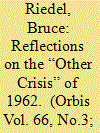

|
|
|
|
|
| Summary/Abstract |
John F. Kennedy confronted a second major crisis in 1962: the Chinese invasion of India, which threatened the territorial integrity of the world’s largest democracy. India appealed for and received US military aid in a major airlift. Kennedy also constrained Pakistan from opening a second front against India. At the peak of the crisis, India appealed for direct American military intervention against China. The 1962 crisis still resonates; the border is in dispute, fueling a trilateral arms race.
|
|
|
|
|
|
|
|
|
|
|
|
|
|
|
|
| 7 |
ID:
183143
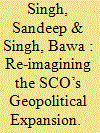

|
|
|
|
|
| Summary/Abstract |
The SCO is one of the biggest geopolitical groupings in the world. It has provided a forum for its members, particularly, Russia and China, to cooperate on the set goals of the Eurasian re-integration. In contrast, SAARC cannot be termed as a successful organization, given the arch–rivalries between India and Pakistan. However, optimists believe that the geopolitical expansion, having India and Pakistan on board, the SCO would have the potential for economic and strategic cooperation. On the other hand, the evolving Sino-Pak axis vis-à-vis India has generated a view that China has offered an SCO platform to make its South Asia Policy a reality. Hence, an attempt has been made to assess the evolving speculations; will the geopolitical expansion of SCO unfold new opportunities or merely make SCO as another SAARC?
|
|
|
|
|
|
|
|
|
|
|
|
|
|
|
|
| 8 |
ID:
173492
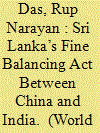

|
|
|
|
|
| Summary/Abstract |
The lexicon of world politics has undergone a transformation after the end of cold war with the disintegration of the erstwhile Soviet Union 1991. The binary approach that ‘either you are with us or against us’ has lost much of its traction in recent times. Now there is an increasing trend towards what is called multiple engagement and it is in this framework that Sri Lanka is balancing its external engagement with two of its powerful neighbours- China and India.
|
|
|
|
|
|
|
|
|
|
|
|
|
|
|
|
| 9 |
ID:
173499


|
|
|
|
|
| Summary/Abstract |
Given its strategic setting in the Indian Ocean region, the nation of Sri Lanka has become very crucial to global and regional powers such as India and China. The external relations of Sri Lanka were based on a neoliberal discourse. Compared to Sri Lanka, the external relations of India were majorly based on realist theoretical perspective. Thus, given the regional influence of India and the close the historical ties and geographical proximity shared by India and Sri Lanka, the foreign policy of India heavily influences the Indo-Sri Lankan relations.
|
|
|
|
|
|
|
|
|
|
|
|
|
|
|
|
|
|
|
|
|